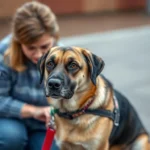
Introduction
Training a dog is an essential part of responsible pet ownership, especially when it comes to puppies. However, if you find yourself with a scared puppy, you might face unique challenges that require a tailored approach. Puppies can experience fear for various reasons, and understanding these emotions is crucial for effective training. This article aims to provide comprehensive help for training scared puppies, helping you foster a trusting relationship and build their confidence.
Understanding Fear in Puppies
Common Causes of Fear
Fear in puppies can stem from several sources. Being aware of these causes can help in addressing the root of the problem.
-
Genetic predisposition: Some breeds are naturally more anxious than others. A puppy’s genetics can influence its temperament, making it more susceptible to fear.
-
Lack of early socialization: Puppies that have not been exposed to various people, animals, and environments during their critical socialization period (between 3 and 14 weeks) may develop fears later on.
-
Traumatic experiences: Past negative experiences, such as harsh training methods or accidents, can leave lasting fears in a puppy’s mind.
Signs of a Scared Puppy
Recognizing signs of fear is vital for addressing the issue effectively. Here are common indicators:
-
Body language signals: A scared puppy may exhibit a low posture, with its tail tucked between its legs and ears flattened against its head.
-
Vocalizations: Whining, yipping, or excessive barking can indicate fear or anxiety.
-
Behavioral reactions: A scared puppy might hide, avoid eye contact, or react defensively to perceived threats.
Preparing for Training
Creating a Safe Environment
Before starting any training, it’s essential to create a calm and safe space for your scared puppy.
-
Importance of a calm space: A quiet area free from distractions will help your puppy feel secure and focused during training sessions.
-
Tips for puppy-proofing the training area: Remove any items that could cause harm or create anxiety, such as loud toys or hazardous objects. Make sure the area is comfortable with soft bedding and toys to encourage a positive environment.
Gathering Training Supplies
Having the right tools can significantly enhance your training experience.
-
Recommended tools: Essential items include a sturdy leash, high-quality treats, and a clicker for positive reinforcement.
-
Importance of positive reinforcement items: Treats and toys should be appealing to your puppy, as these rewards will encourage good behavior and make training enjoyable.
Building Trust and Confidence
Establishing a Bond with Your Puppy
Building a strong bond with your scared puppy is crucial for effective training.
-
Techniques for bonding: Engage in playtime, gentle handling, and interactive activities that promote a sense of security.
-
Importance of patience and consistency: Trust takes time to build. Be patient and consistent in your interactions, allowing your puppy to come to you at its own pace.
Gradual Exposure to Fear Triggers
Desensitizing your puppy to fear-inducing situations can help reduce anxiety.
-
Steps for desensitization: Introduce your puppy slowly to its fear triggers in a controlled manner. For example, if your puppy is afraid of loud noises, start with low-volume sounds and gradually increase the intensity as it becomes more comfortable.
-
Monitoring puppy reactions and adjusting exposure: Always observe your puppy’s reactions. If it shows signs of distress, reduce the intensity or distance from the trigger until it feels safer.
Basic Training Techniques for Scared Puppies
Positive Reinforcement Training
Positive reinforcement is a highly effective method for training scared puppies.
-
Explanation of positive reinforcement: This technique involves rewarding your puppy for desired behaviors, which encourages them to repeat those actions.
-
Examples of rewards: Use treats, praise, or playtime as rewards to motivate your puppy. Ensure that the rewards are immediate to help your puppy associate good behavior with positive outcomes.
Basic Commands to Teach
Teaching your puppy basic commands is fundamental for building confidence and improving communication.
-
Sit, stay, come: These commands are essential for safety and control. Start with simple commands and gradually increase complexity as your puppy becomes more comfortable.
-
Importance of mastering commands for confidence: Successfully learning commands can boost your puppy’s self-esteem, making it feel more secure and less fearful.
Socialization Strategies
Controlled Socialization Experiences
Socialization is key to helping a scared puppy become more confident around people and other animals.
-
Introducing new people and pets gradually: Start with calm and friendly individuals or pets. Allow your puppy to approach at its own pace, providing treats and praise for positive interactions.
-
Setting up playdates with calm, friendly dogs: Choose dogs known for their gentle demeanor. Supervised playdates can help your puppy learn how to interact with others in a safe environment.
Puppy Classes and Group Training
Enrolling your puppy in a training class can provide structured socialization opportunities.
-
Benefits of enrolling in puppy classes: Puppy classes offer controlled environments where your puppy can learn alongside other dogs. This exposure can help reduce fear and anxiety.
-
Tips for choosing the right class: Look for classes that focus on positive reinforcement and are taught by experienced trainers. A small class size can also provide individualized attention.
Addressing Specific Fears
Fear of Loud Noises
Many puppies develop fears of loud noises, which can be particularly challenging.
- Techniques for acclimating to sounds: Use sound desensitization techniques by playing recordings of thunder or fireworks at a low volume, gradually increasing the volume as your puppy becomes more comfortable.
Fear of Strangers
Introducing your puppy to new people can be daunting, but it’s essential for socialization.
- Strategies for introducing new people: Have strangers approach your puppy calmly and quietly, allowing it to sniff and become familiar at its own pace. Use treats to create positive associations with new people.
Fear of Other Animals
A scared puppy may also show fear towards other animals.
- Gradual introductions and safe spaces: Start with brief, controlled meetings with calm dogs. Create a safe space where your puppy can retreat if it feels overwhelmed.
When to Seek Professional Help
Recognizing Severe Fear Issues
While many fears can be managed with patience and training, some cases may require professional intervention.
- Indicators that professional help is needed: If your puppy displays extreme fear responses, such as aggression, excessive trembling, or an inability to be calmed, it may be time to consult a professional.
Choosing a Professional Trainer
Selecting the right trainer can make a significant difference in your puppy’s training journey.
-
Tips for selecting a qualified dog trainer or behaviorist: Look for trainers with a background in fear-based behavior and a focus on positive reinforcement techniques.
-
Questions to ask during the selection process: Inquire about their training methods, experience with scared puppies, and success stories. A good trainer should be able to provide references and details about their approach.
Conclusion
Understanding and training a scared puppy requires a compassionate and informed approach. By recognizing the causes of fear, creating a safe environment, and employing positive reinforcement techniques, pet owners can help their puppies overcome anxiety and build confidence. Remember, patience and consistency are key to this journey, and with time, your scared puppy can transform into a happy, well-adjusted companion.
Training a scared puppy is not just about correcting behavior; it’s about fostering trust and ensuring a loving relationship that will last a lifetime.









